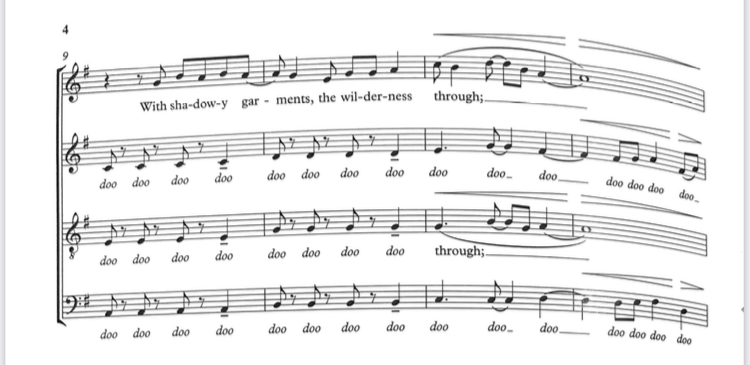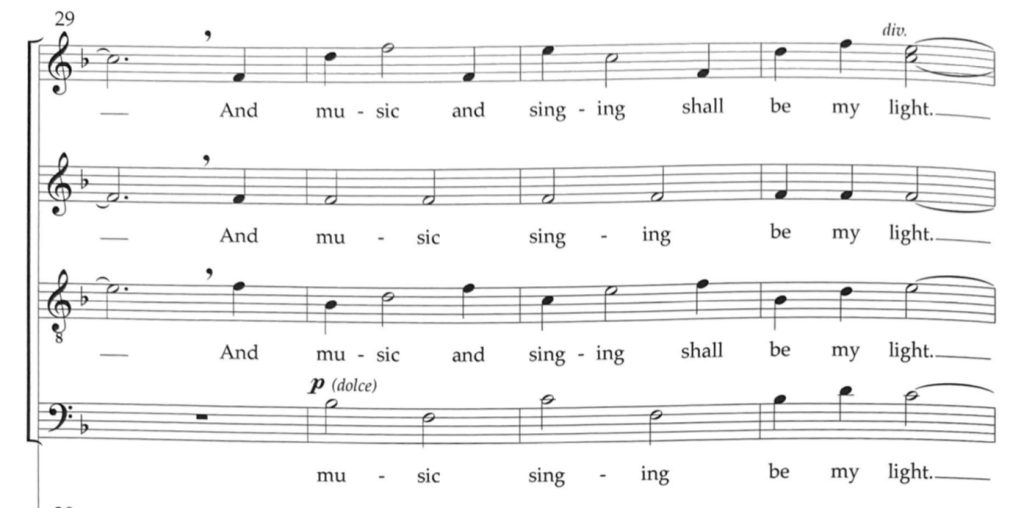Form: Examples
Lauren Tougas and Phoebe Bair
Example 1: BriFormer Tool:
Below is an example of the use of BriFormer to analyze form, specifically for the piece entitled Turlutte acadienne montréalaise:

In this example, we see there are three large sections that look similar and one that looks different. The red/yellow sections could either be considered large verses or a verse-chorus format. The smaller green section is the bridge.
Example 2: Verse-Chorus Form
A good example of “Verse Chorus” form is in “Great God Almighty,” arr. by Stacey V. Gibbs.

Example 3: Through-Composed Form
An example of through-composed form is in the choral work, “She Lingers On” by Zanaida Robles, pictured below. Though the repeating colors reflect similarities in various sections, the work continuously evolves without exactly repeating sections, reflecting the varying emotions and imagery of the text as it is set to music.

Example 4: Strophic Form
An example of Strophic Form is “O Love” by Elaine Hagenberg. This work uses strophic form by applying the same musical setting to each verse of the poem, allowing the melody and harmonies to repeat while subtly adjusting dynamics and expression to match the text’s nuances. This technique emphasizes the poem’s emotional depth and maintains musical interest across the piece.

Example 5: Sentences
A sentence can be seen in “The Birds’ Lullaby” by Sarah Quartel, Measures 5-12. This follows the 2+2+4 pattern described earlier in this Chapter. The structure of the phrases is mirrored and repeated, providing a sense of balance and symmetry.


Example 6: Identifying Shifts
Eric Whitacre’s “She Weeps Over Rahoon” presents a piece where a form diagram presents a bit more of a challenge. “She Weeps Over Rahoon” incorporates elements of variations in musical material reflecting changes in the poem’s mood and imagery. This piece’s form is largely determined by shifts to new tonal centers, particularly through the circle of fifths. Whitacre’s modulations keep the piece moving, allowing you to feel the grief of the narrator. These shifts are indicated in the diagram below.

Example 7: Identifying Cadences
In “Earth Song,” by Frank Ticheli, you can listen for cadences at key points to understand how Ticheli transitions between sections of the music. The cadences help to underline the resolution of the text’s message, providing a sense of finality to each section before moving on to the next idea. Note that this form is through-composed, a form that allows the music to continuously evolve without repeating entire sections verbatim. Cadences in this piece not only serve as musical punctuation but also as key emotional and structural landmarks that guide the listener through the composition’s narrative arc. Ticheli’s compositions often feature emotional and harmonic shifts. See Measures 29-32 of “Earth Song” below for an example of a half-cadence on “light,” which marks a key point in the piece leading into the piece’s climax. This is especially interesting, given that the piece does not feature any clear authentic cadences.

Example 8: Identifying Form
In identifying form, if you were to apply the full set of steps outlined herein above for your approach to form analysis and were to have analyzed the form of “The Embers Tell” by Mattea Williams, you would discover a case for a through-composed form in choral music. This structure allows for continuous development and variation throughout the piece. “The Embers Tell” utilizes continuous flow and a rich palette of dynamics to depict the nuanced nature of its narrative theme. Measures 30-40 of this work are pictured below.
[The Embers Tell, mm. 30–40]

